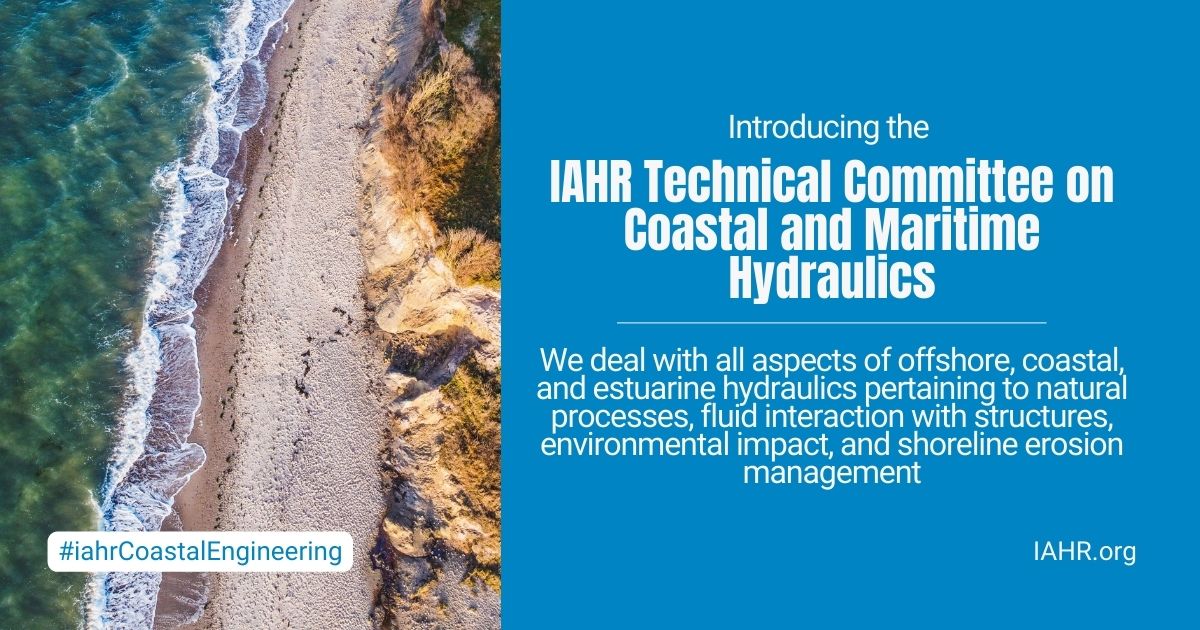Committee on Coastal and Maritime Hydraulics
#iahrCoastalEngineering
Next events
10th International Conference on Physical Modelling in Coastal Science and Engineering (Coastlab26), 23-27 February 2026, IIT Madras, Chennai, India. Chair Prof. Dr. Sriram V and and Prof. K. Murali
Scope
Maritime Hydraulics covers all aspects of maritime, coastal and estuarine problems including coastal morphology, waves, tides, currents, sedimentation and pollution. The activity of the IAHR Maritime Committee is focused on six topics:
Study of environmental parameters such as waves, tides and currents through: Field data collection, analytical methods and numerical and physical modelling techniques. Special emphasis is given to achieve a better understanding of non-conventional parameters such as wave groups, bounded short and long waves, wave asymmetries, directional waves, etc. and their relevance to structural response.
Design of ports & harbours and their optimisation through physical and numerical modelling including design of fixed and floating structures.
Analysis of bed load and suspended load, cross-shore and longshore currents involved in sedimentation and bed evolution, erosion and deposition problems related to structures, and dredging.
Study of pollution problems including convection of pollutants by currents, residual drift, dispersion and diffusion.
Coastal and ecosystem management including the interaction of the coastal environment with coastal developments.
Study of consequences of sea level trends and impacts on coastal engineering.
Contacts with other organisations, such as the Coastal Engineering Research Council (CERC) of the American Society of Civil Engineers, the Permanent International Association of Navigation Congresses (PIANC), the International Towing Tank Conference (ITTC), are well established.
The present effort is mainly focused on improving numerical and mathematical models of coastal processes through a better understanding of the associated complex physics. As well, there is the need for certain field data to validate these numerical models.
Many laboratories are now equipped with segmented wave generators that can simulate the multidirectional characteristics of natural sea states. Although the use of multidirectional waves provides a more accurate representation of wave interactions with structures, often resulting in more cost-effective and safer designs, there are limitations again in the lack of sufficient field data.
One of the priorities of the IAHR Maritime Hydraulics Committee is to form international Working Groups for standardising and validating analysis algorithms that can be used both in field and laboratory situations.
Mission
To deal with all aspects of offshore, coastal, and estuarine hydraulics pertaining to: natural processes, fluid interaction with structures, environmental impact, and shoreline erosion management. Its activity focuses on topics such as: waves and currents, effect of boundaries, sedimentation and coastal morphology, sea level change, relevant environmental issues.
Research Agenda
Beach Dewatering: Recent projects, academic publications, and the increasing focus on coastal erosion bring beach drainage technology into the forescene of research on retarding each erosion process.
Refined wave modeling: A need to further refine wave models against well tested experimental results is seen as a first step towards combined laboratory/numerical approaches to complex maritime hydraulics problems.
Sea outfalls: Sound technical guidelines based on scientific reasoning are required for the proper design of sea outfalls protection against environmental loading
Sea level rise: The expected rise in sea level and associated climate changes will most probably have severe consequences for coastal and estuarine ma
